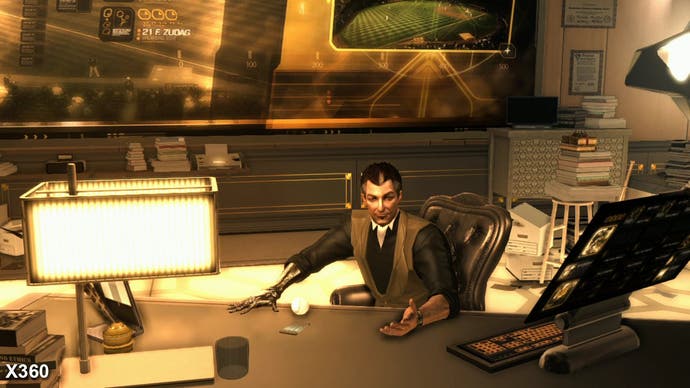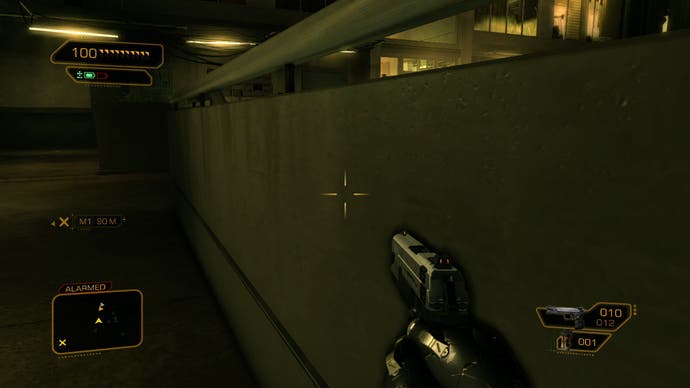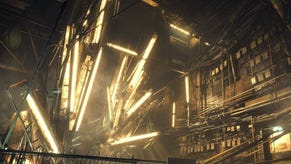Face-Off: Deus Ex: Human Revolution
The truth will change SKU.
| - | Xbox 360 | PlayStation 3 |
|---|---|---|
| Disc Size | 6.8GB | 7.84GB |
| Install | 6.8GB (optional) | 2895MB (mandatory) |
| Surround Support | Dolby Digital | Dolby Digital, 5.1LPCM |
A fledgling development studio shipping its first game based on an all-new engine and a hugely ambitious game design... What could possibly go wrong?
Deus Ex: Human Revolution scored extremely well in a review based primarily on Xbox 360 code, but how does the PlayStation 3 version compare? And what's the score with the PC rendition of the game, outsourced to long-time Eidos associate, Nixxes? Is it a basic port, or are there significant and worthwhile enhancements over and above the basic ability to power past console performance limitations and run with higher resolutions?
In this article we'll be comparing and dissecting all three versions of the game, kicking off as always with a head-to-head video comparison, backed up by an exhaustive Deus Ex: Human Revolution 720p comparison gallery.
As the video demonstrates, Deus Ex: Human Revolution is another welcome example of a really close cross-platform project. Native 720p appears to be confirmed on both platforms, and both have v-sync engaged, meaning no screen-tear whatsoever, The implementation of all components in the game's visual make-up appears to be virtually identical (even down to shadowing bugs) with the most obvious difference being the skewed gamma level on Xbox 360 providing darker, richer colours in the default settings (though with the possibility of black crush). There also appears to a small amount of blur on the Microsoft platform that we don't see on PlayStation 3 - a result of differing anti-aliasing implementations.
Deus Ex appears to be our first use of NVIDIA's FXAA anti-aliasing technology on Xbox 360. Devised by Timothy Lottes and covered in some depth in a recent Digital Foundry article, FXAA works by applying an intelligent blur to the image that both smoothes jaggies and reduces the contrast of sub-pixel detail, with minimal impact on the base artwork. While the version used in Human Revolution isn't quite so refined as the latest iterations of Lottes' work that we looked at, it still does an admirable job in reducing aliasing artifacting.
Quite what's going on with the PlayStation 3 version isn't so clear. The slight blur we see on Xbox 360 doesn't seem to be present, suggesting that either FXAA has been rejigged and re-implemented for PlayStation 3, or else MLAA is being used. In truth, analysis of post-process anti-aliasing techniques going forward is going to get a lot more difficult to pin down - we can only go by what we see and it seems to be the case that while PS3 is cleaner, the anti-aliasing isn't quite so effective, with edge shimmering significantly more noticeable.


So why use post-process AA at all? Well, the whole aesthetic of Deus Ex is achieved through some phenomenal use of light and we're almost certain that the sheer volume of dynamic lights in play demands the use of a deferred rendering engine, similar in principle to that seen in the PS3 Killzone games, Metro 2033 and many other recent titles.
On DX9-level hardware, this approach doesn't play nicely with traditional multisample anti-aliasing, and even where it can be implemented, the memory requirement can be frightening - and RAM is obviously at a premium on the consoles. In this respect, switching to post-process AA means that the memory hit is minimal and the speed is quite phenomenal: FXAA on console works its magic in around 1ms of GPU time, where a 30FPS game has a budget of 33ms per frame.
The lighting really does define the game. It's a core part of its visual identity, and Deus Ex works hard to complement this with effective real-time shadowing. On top of this, Eidos Montreal has also added screen-space ambient occlusion (SSAO) to provide an additional layer of depth to the scene. The implementation can be quite heavy, most notably apparent when Jensen goes into cover, surrounded by a thick black halo around the character model, which does stick out somewhat. However, the effect on environments and props seems to work well in terms of the overall aesthetic.


On a more general level, the challenge facing the Deus Ex developers was immense. On the one hand, Human Revolution needs to compete with state-of-the-art console shooters - the most hotly contested sector of the core video games market - while at the same time accommodating a fully featured RPG component. The memory implications for the latter are especially onerous: the developers had to create a fully realised world, and a range of labyrinthine mission maps complete with many areas that players probably won't get to see without multiple playthroughs.









